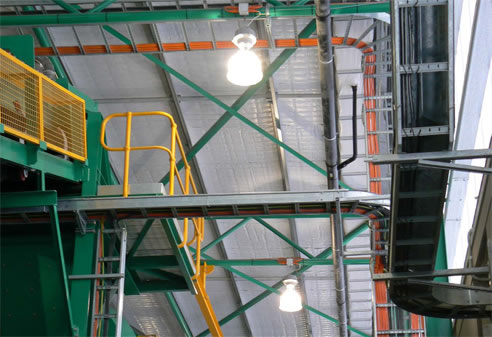High Bay Luminaire for Factory Lighting from WE-EF Lighting High Bay luminaires have been around for a long time and are one of the most commonly used forms of luminaire. The use of borosilicate in the production of a high performance delivery of light is not new but has been, in recent years, neglected in Australia.
Why Borosilicate?
Refractor or Reflector?
Exceptional Efficiency
So what is the benefit?
How does this work? IVH The case against plastic lenses IESNA standards stipulate that a 3% depreciation factor should be applied to borosilicate refractors when used in a moderately dirty environment; this contrasts with plastic reflectors where under the same circumstances a 7% depreciation factor is recommended; Acrylic is a thermo-plastic, it is temperature and UV sensitive; combine both and the result is accelerated degradation; add humidity and the degradation process is further exacerbated; Continuous service life is rated at 80°C. This means that rated life is diminished above this value resulting in accelerated degradation; Highbays, it is worth recording, often work in extreme ambient conditions; The assumption that plastic diffusers are the best solution in areas subject to impact needs to be questioned. The ageing of plastics used in lighting applications, where heat and UV is normal and sometimes humidity is present, results in embrittlement of the material, this results in the potential for shattering upon impact.
|
03 8587 0400 6/13 Downard Street, Braeside, Vic, 3195
|


 Modern Catenary Solution Fit for
Modern Catenary Solution Fit for WE-EF's New Managing Director for
WE-EF's New Managing Director for A New Era for WE-EF LIGHTING – A Home
A New Era for WE-EF LIGHTING – A Home Myers Park Lighting Upgrade:
Myers Park Lighting Upgrade: Bridging the Past and Future: Old Murray
Bridging the Past and Future: Old Murray WE-EF Profile Projectors for Sharper
WE-EF Profile Projectors for Sharper Award-winning Bay Pavilions, Arts +
Award-winning Bay Pavilions, Arts + Enhancing Transit Experience at Byron
Enhancing Transit Experience at Byron Intelligently Illuminating the Bay Run
Intelligently Illuminating the Bay Run WE-EF Lighting's Role in Protecting
WE-EF Lighting's Role in Protecting Sustainable LED Upgrade Kit from WE-EF
Sustainable LED Upgrade Kit from WE-EF A Natural Paradise Rottnest Island by
A Natural Paradise Rottnest Island by WE-EF LIGHTING's Braeside Expansion
WE-EF LIGHTING's Braeside Expansion Street and Area Pole-Mounted Luminaires
Street and Area Pole-Mounted Luminaires Smart Lighting Control Technology from
Smart Lighting Control Technology from High-Output Floodlights with Modern LED
High-Output Floodlights with Modern LED Bondi Beach Pavilion Reimagined by WE-EF
Bondi Beach Pavilion Reimagined by WE-EF Balancing Needs: Sea Turtle Conservation
Balancing Needs: Sea Turtle Conservation Architecturally Pleasing Recessed
Architecturally Pleasing Recessed Luminaires for Lake Macquarie Multi-Arts
Luminaires for Lake Macquarie Multi-Arts
